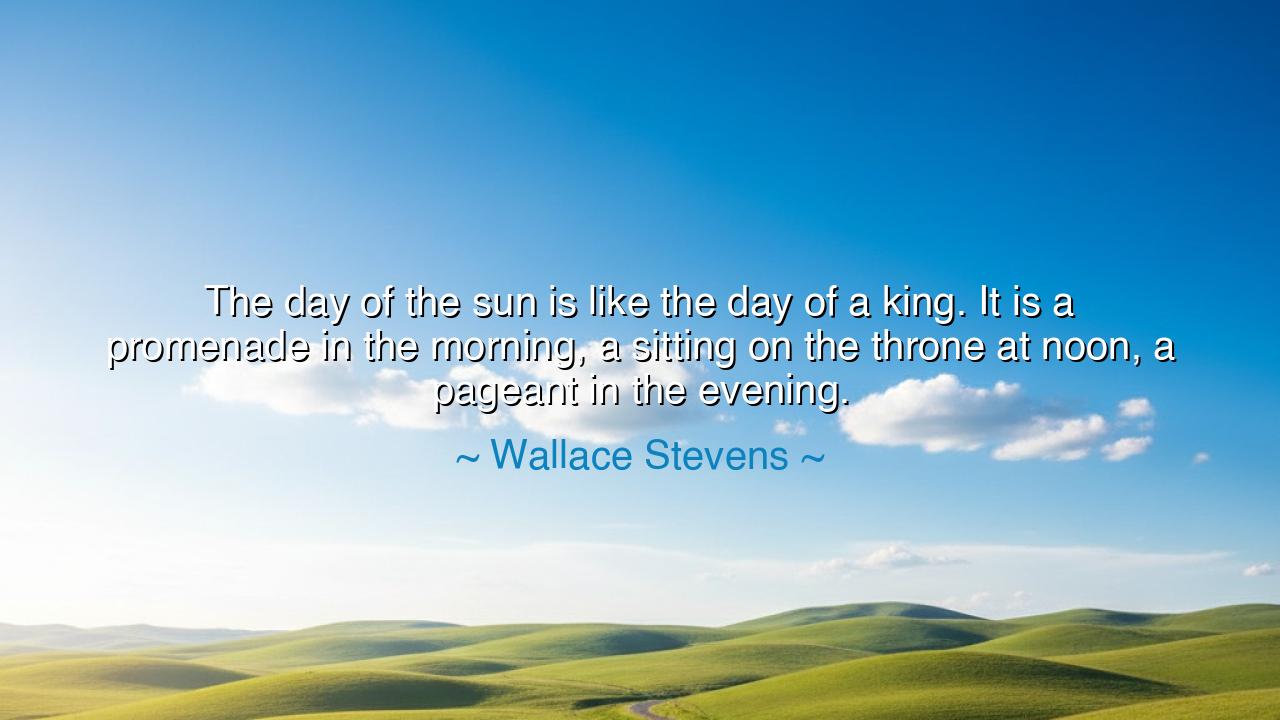
The day of the sun is like the day of a king. It is a promenade
The day of the sun is like the day of a king. It is a promenade in the morning, a sitting on the throne at noon, a pageant in the evening.






Wallace Stevens, the poet-philosopher of light and symbol, once declared: “The day of the sun is like the day of a king. It is a promenade in the morning, a sitting on the throne at noon, a pageant in the evening.” These words, adorned with majesty, are not merely an observation of nature’s cycle, but a meditation on power, beauty, and the eternal rhythm of life. He elevates the journey of the sun into the drama of kingship, showing us how the heavens mirror the struggles and triumphs of human order.
In the morning, the sun begins with a promenade. This is no hurried march but a gentle procession, as if the monarch greets his kingdom at dawn. The air is cool, the earth is quiet, and all creation looks upward, anticipating his rise. So too in human life: our beginnings, whether of a day or of a destiny, should be carried with grace, not haste, for the world first beholds us in our rising. This stage is not about conquest, but about promise.
At noon, the sun sits upon the throne. Here it reaches its zenith, unmoving, unchallenged, radiant in its strength. This is the image of power fulfilled—the hour when shadows shrink and the sovereign’s authority is absolute. In the life of a man or woman, noon represents the height of vigor, when one’s powers are greatest, and the crown of mastery rests most securely. Yet it is also a fragile moment, for after the height comes the descent.
Then arrives the evening, when the sun becomes a pageant. No longer a sovereign seated in power, it transforms into art, into splendor, into memory. Colors bloom across the sky, as if the king gives his people a final gift before withdrawing into night. This pageant teaches us that the decline of power need not be shameful—it can be beautiful, leaving behind awe and inspiration even as the day ends. Thus, Stevens reminds us that endings, too, carry dignity when embraced with majesty.
History offers reflections of this cosmic truth. Consider Alexander the Great: his morning was his youthful conquests, swift and promising; his noon was the unmatched height of empire, ruling from Greece to India; and his evening was his early death, leaving behind a pageant of legend that inspired generations long after his light was extinguished. The sun’s path mirrors the fate of all who rise to greatness.
The deeper meaning of Stevens’ words is not bound to kings or empires alone. Each life, each day, is its own monarchy. We rise, we reign, and we fade. The question is not whether the evening will come, but how we will adorn it. Will our decline be bitter, or will it shine with the beauty of a pageant, leaving a legacy for others to remember? The sun teaches us that decline can be as glorious as ascent, if we accept it with grace.
Therefore, let us take this teaching to heart: live your morning with promise, your noon with strength, and your evening with beauty. Recognize the stages of your life as part of a royal procession, and do not mourn the passing of each phase, for each holds its own majesty. For as the day of the sun teaches, to live is to rise, to rule, and to set—and in each moment, if embraced with dignity, there is greatness.






AAdministratorAdministrator
Welcome, honored guests. Please leave a comment, we will respond soon